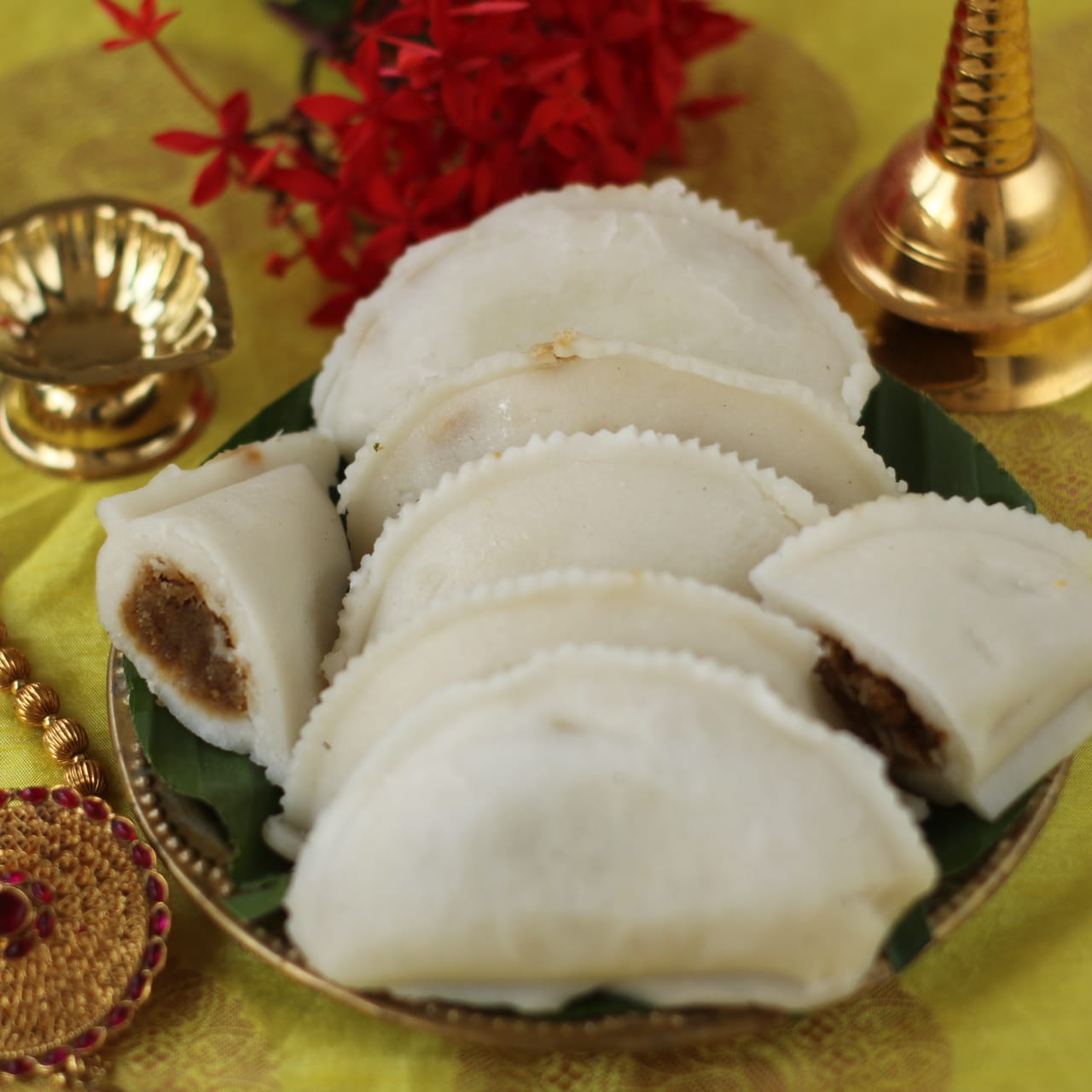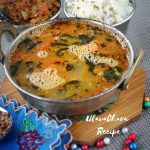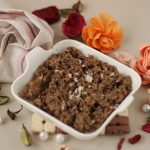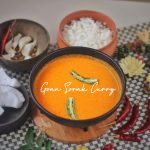Relish this dumplings of divine delight called "poornam kudumulu" that is delectably delightful on your palates which can be tweaked to taste with tons of flavors. The combination of rice flour, coconut, jaggery, ghee and cardamom powder are match made in flavor heaven and any foodie must realize it by tasting this "poornam Kudumulu" atleast once.
Index:
Just Glance Through These Engaging Topics To Know More Facts Far And Beyond The Recipe:
- A Prelude On The Time Tested Glory Of Andhra Cuisine
A Look Into The State's Desserts And Delicacies
A Brief Note On Poornam Kudumulu
Regional variations Of Poornam Kudumulu
The Significance Of Poornam Kudumulu
Needed Ingredients To Make Poornam Kudumulu
Step Wise Directions To Make Poornam Kudumulu
- Faqs
9. Things To Remember
10. Nutritional Value
11. Poornam Kudumulu - A Recap
12. Alluring Accompaniments For Poornam Kudumulu
13. A Sample Andhra Festive Thali That Would Include Poornam Kudumulu As A Delicacy
14. The Takeaway
Poornam Kudumulu is a traditional South Indian sweet dish from the state of Andhra often prepared during festivals like Ganesh Chaturthi. It's a delicious steamed dumpling filled with a sweet jaggery and coconut mixture.
A Prelude On The Time Tested Glory Of Andhra Cuisine:
Andhra cuisine, renowned for its bold and fiery flavors, is a culinary journey through the southern state of Andhra Pradesh in India. Characterized by its generous use of red and green chilies, tamarind, and aromatic spices, this cuisine offers a wide range of dishes that can tantalize the taste buds of both spice lovers and connoisseurs of diverse flavors. Andhra cuisine includes iconic dishes such as spicy Andhra chicken or mutton curry, tangy Gongura pickle, and the famous Hyderabadi Biryani, which also has its roots in Andhra Pradesh. Vegetarians can savor specialties like Gutti Vankaya (stuffed eggplant curry) or the delectable Pesarattu (green gram dosa). With its rich culinary heritage, Andhra cuisine stands as a testament to the art of balancing heat, spice, and flavor to create an unforgettable gastronomic experience.
A Look Into The State's Desserts And Delicacies:
A comprehensive study of Andhra Pradesh's desserts and delicacies reveals a culinary landscape as diverse as the state itself. With its roots deeply embedded in traditional South Indian cuisine, Andhra desserts offer a unique blend of flavors and textures that cater to a wide range of palates. From the crispy and chewy Ariselu to the paper-thin Pootharekulu and the sweet, custard-like Junnu, the state's desserts showcase a mastery of ingredients like rice flour, jaggery, coconut, and various lentils. These sweets are not only a part of festive traditions but also reflect the cultural richness and heritage of Andhra Pradesh. Additionally, savory delicacies like the iconic Andhra chicken curry and spicy Gongura pickle add a savory dimension to the culinary journey, making Andhra Pradesh a gastronomic paradise for those seeking a taste of bold and vibrant flavors.
A Brief Note On Poornam Kudumulu:
Poornam Kudumulu, also known simply as Kudumulu, are a popular South Indian sweet dish. These steamed dumplings are typically prepared during festivals and special occasions, especially as an offering to deities during Ganesh Chaturthi. Poornam Kudumulu are made by enclosing a sweet filling of grated coconut and jaggery within a rice flour dough, which is then steamed until it becomes soft and translucent. The outer covering is soft and slightly chewy, while the inner filling is sweet, aromatic, and often flavored with cardamom. These delicious dumplings are not only a delight to the taste buds but also hold cultural and religious significance in South Indian traditions.
Regional variations Of Poornam Kudumulu:
Andhra Coastal Region: Along the coastal areas of Andhra Pradesh, especially in places like Visakhapatnam and Vijayawada, Poornam Kudumulu are often prepared with a spicier twist. Green chilies are added to the sweet coconut and jaggery filling, creating a unique blend of sweet and spicy flavors. These dumplings are sometimes known as "Teepi Kudumulu," with "teepi" meaning sweet, referring to the sweet and spicy contrast.
Rayalaseema Region: In the Rayalaseema region of Andhra Pradesh, Poornam Kudumulu are made with an emphasis on the quality and flavor of the rice flour used for the outer covering. The rice flour dough is meticulously prepared to be soft and pliable, resulting in delicate dumplings. The filling typically consists of freshly grated coconut, jaggery, and a hint of cardamom.
Telangana Region: While Telangana was formerly a part of Andhra Pradesh before becoming a separate state, the culinary traditions of this region have influenced Andhra cuisine. In some areas of Telangana, Poornam Kudumulu are made with slightly thicker rice flour dough, and the sweet filling may include sesame seeds for added texture and flavor.
- Krishna and Guntur Districts: These districts in Andhra Pradesh are known for their spicy cuisine, and this influence extends to their version of Poornam Kudumulu. The filling can be exceptionally spicy, with the addition of red and green chilies, along with tamarind pulp, making them a unique and fiery variation.
East Godavari District: In the East Godavari region, there is a special variation of Poornam Kudumulu called "Pala Kova Kudumulu." These dumplings feature a creamy and rich filling made from freshly prepared milk solids (khoya or mawa) combined with sugar or jaggery.
These regional variations within Andhra Pradesh highlight the adaptability and creativity of Andhra cuisine. While the basic concept of Poornam Kudumulu remains consistent, the use of different ingredients, flavors, and levels of spiciness can vary widely from one sub-region to another, offering a diverse culinary experience for those exploring the state's cuisine.
The Significance Of Poornam Kudumulu:
Poornam Kudumulu, hold significant cultural and religious importance, particularly in South India, and they are prepared and offered during various festivals and special occasions. Here are some of the key significance of Poornam Kudumulu:
Ganesh Chaturthi: Poornam Kudumulu are closely associated with the celebration of Ganesh Chaturthi, a major Hindu festival dedicated to Lord Ganesha, the elephant-headed god of wisdom and prosperity. It is believed that Lord Ganesha has a special fondness for these sweet dumplings. During Ganesh Chaturthi, devotees prepare Poornam Kudumulu as a favorite offering (prasad) to Lord Ganesha as a symbol of devotion and gratitude.
Symbol of Wholeness and Fullness: The term "Poornam" in Poornam Kudumulu signifies fullness or completeness. The sweet filling inside the dumplings represents the sweetness and fullness of life, while the rice flour dough symbolizes the outer covering of life's experiences and challenges. The act of making and offering Poornam Kudumulu is a way of expressing gratitude for the fullness of life.
Traditional Family Bonding: Preparing Poornam Kudumulu is often a family affair, where multiple generations come together in the kitchen to make these dumplings. It fosters a sense of togetherness, strengthens family bonds, and allows for the passing down of culinary traditions from one generation to the next.
Variation in Rituals: Different regions and communities within South India may have variations in the way Poornam Kudumulu are prepared and offered. These variations reflect local customs, traditions, and the unique cultural identity of each group.
Auspicious Occasions: Poornam Kudumulu are not limited to Ganesh Chaturthi alone. They are also prepared and offered during other auspicious occasions such as weddings, housewarming ceremonies, and religious festivals. Their presence at such events is believed to bring blessings and prosperity to the occasion.
Spiritual Significance: Beyond their cultural and festive significance, Poornam Kudumulu can carry spiritual symbolism. The act of preparing these dumplings with devotion and offering them to deities is seen as a form of self-surrender and devotion to the divine.
In summary, Poornam Kudumulu are more than just a sweet treat; they represent a deep connection to cultural traditions, religious beliefs, and the expression of gratitude and devotion. These dumplings are a way for people in South India to celebrate their heritage, strengthen family bonds, and pay homage to their deities, particularly Lord Ganesha, while savoring the delightful flavors of this beloved sweet dish.

Needed Ingredients To Make Poornam Kudumulu:
Rice Flour: Rice flour serves as the primary ingredient for the outer covering of Poornam Kudumulu. It is used to make a pliable dough that encases the sweet filling.
Grated Coconut: Grated coconut is a key component of the sweet filling inside Poornam Kudumulu. It adds a tropical, nutty flavor and a pleasing texture.
Jaggery: Jaggery, a natural sweetener made from sugarcane juice or palm sap, is used to sweeten the coconut filling. It imparts a rich, caramel-like sweetness.
Cardamom Powder: Cardamom powder is added to the filling for its aromatic and fragrant qualities. It enhances the overall flavor of Poornam Kudumulu.
Ghee (Clarified Butter): In some variations, a small amount of ghee is used to enhance the flavor and richness of the filling. It adds a subtle buttery note.
- Sesame Oil: It Is used To add fragrance to the kudumulu.
Step Wise Directions To Make Poornam Kudumulu:
Preparing the Rice Flour Dough: Cook rice flour with boiling water until it forms a soft, non-sticky dough. This dough will serve as the outer covering for the dumplings.
Making the Sweet Filling (Poornam): Mix grated coconut and jaggery in a pan, then cook until the jaggery melts and blends with the coconut, creating a sweet and aromatic filling. Add cardamom powder for flavor.
Shaping the Dumplings: Take a portion of the rice flour dough, shape it into a cup, and add the sweet filling in the center. Carefully seal the edges to form a dumpling shape.
Steaming the Dumplings: Arrange the dumplings on greased steamer plates or idli molds and steam them until they become translucent and firm.
Cooling and Serving: Allow the Poornam Kudumulu to cool slightly before serving. They are traditionally offered to deities during festivals and enjoyed as a sweet treat.
Bring water to a boil in a saucepan. Add a pinch of salt and a teaspoon of oil to it.
Reduce the heat to low and gradually add the rice flour to the boiling water while stirring continuously to avoid lumps.
Cook the rice flour mixture for a few minutes until it comes together into a soft, non-sticky dough. It should have a consistency similar to chapati dough.
Turn off the heat and cover the dough with a wet cloth. Allow it to cool for a few minutes.
In a separate pan, heat a teaspoon of ghee on medium heat.
Add the grated coconut to the pan and sauté for a couple of minutes until it turns slightly golden and aromatic.
Add the powdered or grated jaggery to the coconut and mix well. Continue to cook on low heat, stirring constantly, until the jaggery melts and blends with the coconut. This will take about 5-7 minutes.
Add a pinch of cardamom powder for flavor and mix it into the coconut-jaggery mixture.
Once the mixture thickens and comes together as a cohesive mass (similar to a dough), remove it from the heat. Allow it to cool to room temperature.
Take a small portion of the cooled rice flour dough and shape it into a small cup or ball in your palm. Make a well in the center to hold the sweet filling.
Place a small amount of the sweet coconut-jaggery filling (Poornam) inside the well you created in the rice flour dough.
Carefully seal the edges of the rice flour dough, enclosing the filling, and shape it into a small dumpling. Ensure there are no cracks.
Repeat this process with the remaining dough and filling.
Prepare a steamer by filling it with water and bringing it to a boil.
Grease the steamer plates or idli molds with a little oil.
Place the Poornam Kudumulu on the greased plates, leaving some space between each dumpling.
Steam the dumplings for about 10-12 minutes until they become translucent and firm.
Remove them from the steamer and allow them to cool slightly before serving.
Serve it with a sizzling cup of aromatic filter coffee or tea.
Things To Remember:
Use Fresh Ingredients: Use fresh grated coconut and quality jaggery to ensure the best flavor and texture for the sweet filling.
Rice Flour Consistency: Achieve the right consistency of rice flour dough. It should be soft, pliable, and not too dry or too wet. Adjust the water carefully while kneading.
Even Dumpling Thickness: Ensure that the rice flour dough is evenly rolled and the dumplings have a consistent thickness. This helps in uniform steaming.
Proper Steaming: Steam the dumplings on low to medium heat. Overcooking can make them tough, while under cooking can result in a raw taste.
Seal the Dumplings Well: Make sure to seal the edges of the dumplings properly to prevent any leakage of the sweet filling during steaming.
Variation in Filling: Experiment with the sweet filling by adding ingredients like roasted sesame seeds, chopped nuts, or a pinch of grated nutmeg for extra flavor and texture.
Flavor Balance: Pay attention to the balance of flavors. Adjust the amount of jaggery and cardamom powder to suit your taste preferences.
Grease Steamer Plates: Grease the steamer plates or idli molds well to prevent sticking. You can use a little oil or ghee for this purpose.
Traditional Techniques: If possible, learn from someone experienced in making Poornam Kudumulu, as traditional techniques and family recipes often yield the best results.
Practice and Patience: Making perfect Poornam Kudumulu may take some practice. Don't be discouraged by initial attempts; as you gain experience, your dumplings will improve.
Faqs:
What is the key ingredient in the filling of Poornam Kudumulu?
- The main ingredients in the filling are grated coconut and jaggery, which combine to create a sweet and flavorful mixture. Cardamom powder is often added for extra flavor.
Can I make Poornam Kudumulu with store-bought rice flour?
- Yes, you can use store-bought rice flour to make Poornam Kudumulu. However, ensure that it is of good quality and suitable for making dumplings. Homemade rice flour is also a popular choice for authenticity.
Is it difficult to shape the dumplings?
- Shaping the dumplings may require some practice, but it is not overly difficult. Start with small portions of dough and filling, and as you become more familiar with the process, you can create uniform dumplings.
Can Poornam Kudumulu be stored for later consumption?
- Poornam Kudumulu are best enjoyed fresh, but you can store them in an airtight container in the refrigerator for a day or two. However, they may lose some of their texture and freshness over time.
Can I make savory variations of Kudumulu?
- Yes, you can make savory variations of Kudumulu by filling them with ingredients like spiced lentils, grated vegetables, or minced meat. These are known as "Upma Kudumulu" or "Savory Kudumulu."
What is the traditional method of steaming Poornam Kudumulu?
- Poornam Kudumulu are traditionally steamed in an idli steamer or in specialized steamer plates. They are placed in the steamer and cooked until they become translucent and firm.
Poornam Kudumulu: A Recap:
- Nature: Poornam Kudumulu are traditional South Indian steamed dumplings, a sweet culinary delight.
- Color: They often have a pale white translucent appearance with a light golden hue.
- Texture: Poornam Kudumulu feature a soft, slightly chewy rice flour outer covering and a tender, sweet coconut-jaggery filling.
- Taste: They offer a harmonious blend of sweet and mildly aromatic flavors, with a hint of cardamom.
- Consistency: The consistency is delicately soft for the outer covering and moist yet not overly syrupy for the filling.
- Flavor: Poornam Kudumulu have a delightful, balanced flavor profile combining the nutty sweetness of coconut and the rich sweetness of jaggery.
- Smell: They exude a pleasant aroma, predominantly of coconut and cardamom, as they are steamed to perfection.
Alluring Accompaniments For Poornam Kudumulu:
Poornam Kudumulu, with their sweet and nutty flavors, pair wonderfully with a variety of accompaniments. Here are some nice accompaniments to enjoy with Poornam Kudumulu:
Coconut Milk (chilled): A classic South Indian coconut drink made with grated coconut, cardamom, and sugar or jaggery complements the sweet dumplings.
Cardamom-flavored Milk: A warm cup of milk infused with cardamom powder and a touch of saffron or a few strands of saffron threads makes for a comforting and aromatic accompaniment.
Ghee (Clarified Butter): A small serving of warm ghee for dipping or drizzling over the dumplings adds richness and enhances the overall flavor.
4. Fresh Fruits: Serve Poornam Kudumulu with slices of ripe banana, mango, or any seasonal fruit. The natural sweetness of the fruits complements the dumplings.
A Sample Andhra Festive Thali That Would Include Poornam Kudumulu As A Delicacy:
Appetizer:
1. Guggillu: A warm and savory preparation made with soaked and boiled chana dal (split chickpeas) mixed with spices and grated coconut.
Main Course Meal With Rice:
2. Pulihora: Tangy and spicy tamarind rice flavored with mustard seeds, curry leaves, and a hint of turmeric.
- Cabbage Poriyal: Stir-fried cabbage with mustard seeds, urad dal, and grated coconut.
- Avakaya: Andhra's famous spicy mango pickle, adding a burst of flavors to the thali.
- Rasam: A comforting tomato and tamarind-based soup with spices, typically served as a palate cleanser.
- Tomato Pappu: A simple yet delicious dal preparation with red gram (toor dal) and tomatoes, tempered with mustard seeds, cumin, and curry leaves.
7. Poornam Kudumulu: Steamed rice flour dumplings filled with sweet coconut and jaggery filling, offering a delightful sweetness.
8. Semiya Payasam: A vermicelli and milk-based dessert with cardamom and saffron, garnished with cashews and raisins.
9. Side Dish:. Gutti Vankaya: Stuffed baby eggplants cooked in a flavorful masala made from spices, coconut, and tamarind.
10. Bread:. Pulka or Roti: Soft and fluffy Indian bread to accompany the main dishes.
11. Condiments: Curd: Homemade yogurt or curd to balance the spiciness of the dishes.
12. Beverage:. Buttermilk: A refreshing and cooling buttermilk seasoned with curry leaves, green chilies, and ginger.
13. Lemon Wedges: Slices of lemon to add tanginess to your meal.
The Takeaway:
This Andhra festive delight Poornam Kudumulu is the celebration of rich and diverse flavors in traditional South Indian cuisine. This delicacy represents the cultural and culinary heritage of Andhra Pradesh, with its blend of flavors. It showcases the importance of balance and harmony in a dish, with each component contributing to a memorable dining experience. Poornam Kudumulu, as the sweet finale, symbolize the sweet moments of life and the joy of celebrating festivals like Ganesh Chaturthi with family and friends.
Ingredients
Directions
Bring water to a boil in a saucepan. Add a pinch of salt and a teaspoon of oil to it.
Reduce the heat to low and gradually add the rice flour to the boiling water while stirring continuously to avoid lumps.
Cook the rice flour mixture for a few minutes until it comes together into a soft, non-sticky dough. It should have a consistency similar to chapati dough.
Turn off the heat and cover the dough with a wet cloth. Allow it to cool for a few minutes.
In a separate pan, heat a teaspoon of ghee on medium heat.
Add the grated coconut to the pan and sauté for a couple of minutes until it turns slightly golden and aromatic.
Add the powdered or grated jaggery to the coconut and mix well. Continue to cook on low heat, stirring constantly, until the jaggery melts and blends with the coconut. This will take about 5-7 minutes.
Add a pinch of cardamom powder for flavor and mix it into the coconut-jaggery mixture.
Once the mixture thickens and comes together as a cohesive mass (similar to a dough), remove it from the heat. Allow it to cool to room temperature.
Take a small portion of the cooled rice flour dough and shape it into a small cup or ball in your palm. Make a well in the center to hold the sweet filling.
Place a small amount of the sweet coconut-jaggery filling (Poornam) inside the well you created in the rice flour dough.
Carefully seal the edges of the rice flour dough, enclosing the filling, and shape it into a small dumpling. Ensure there are no cracks.
Repeat this process with the remaining dough and filling.
Prepare a steamer by filling it with water and bringing it to a boil.
Grease the steamer plates or idli molds with a little oil.
Place the Poornam Kudumulu on the greased plates, leaving some space between each dumpling.
Steam the dumplings for about 10-12 minutes until they become translucent and firm.
Remove them from the steamer and allow them to cool slightly before serving.
Serve it with a sizzling cup of aromatic filter coffee or tea.





